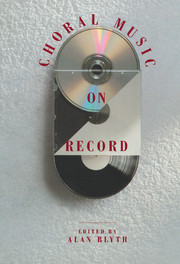Book contents
- Frontmatter
- Contents
- Preface
- Monteverdi: Vespers (1610)
- J.S. Bach: St John Passion
- J.S. Bach: St Matthew Passion
- J.S. Bach: Mass in B Minor
- Handel: Messiah
- Mozart: Requiem Mass
- Haydn: The Creation
- Haydn: The Seasons
- Beethoven: Missa Solemnis
- Mendelssohn: Elijah
- Rossini: Stabat mater Petite messe solennelle
- Berlioz: Grande Messe des Morts Te Deum L'Enfance du Christ
- Verdi: Requiem Mass
- Brahms: A German Requiem
- Fauré: Requiem
- Elgar: The Dream of Gerontius
- Walton: Belshazzar's Feast, Tippett: A Child of Our Time, Britten: War Requiem
- Stravinsky: The Wedding Symphony of Psalms
- Janáček: Glagolitic Mass
- Discographies
- Index
J.S. Bach: St Matthew Passion
Published online by Cambridge University Press: 02 December 2009
- Frontmatter
- Contents
- Preface
- Monteverdi: Vespers (1610)
- J.S. Bach: St John Passion
- J.S. Bach: St Matthew Passion
- J.S. Bach: Mass in B Minor
- Handel: Messiah
- Mozart: Requiem Mass
- Haydn: The Creation
- Haydn: The Seasons
- Beethoven: Missa Solemnis
- Mendelssohn: Elijah
- Rossini: Stabat mater Petite messe solennelle
- Berlioz: Grande Messe des Morts Te Deum L'Enfance du Christ
- Verdi: Requiem Mass
- Brahms: A German Requiem
- Fauré: Requiem
- Elgar: The Dream of Gerontius
- Walton: Belshazzar's Feast, Tippett: A Child of Our Time, Britten: War Requiem
- Stravinsky: The Wedding Symphony of Psalms
- Janáček: Glagolitic Mass
- Discographies
- Index
Summary
The St Matthew Passion is the penultimate Passion of five that Bach's sons recalled their father having written, and it is the second of the three of which we have certain knowledge. The first of the three is the St John Passion, BWV 245, which is discussed in the previous chapter, and the third is the St Mark Passion, written in 1731, for which only the text has been preserved. Very early on in the nineteenth-century Bach Revival, however, scholars realised that the St Mark Passion contained many reworkings of music used elsewhere, and several conjectural recoveries of lost choruses and arias have been made. There is even a recording of a completely reconstructed setting!
The St Matthew Passion (hereinafter SMP), on the other hand, contains little that is borrowed and almost certainly nothing that has been reworked from pre-existing music. In fact, as Joshua Rifkin has cogently argued, the SMP may have been composed for ‘essentially private reasons’ and was also ‘the first vocal contribution to that remarkable, and evidently self-motivated, series of “exemplary” works so strikingly characteristic of his output; and it stands, too, as the piece that marked his inward resignation from his job as Thomaskantor’.
The first version was given its first performance in the Thomaskirche, Leipzig, on 11 April 1727. Originally, there was but one continuo line that accompanied the two four-voice choirs rather than two independent ones, and the obbligato instrument in the aria ‘Komm süsses Kreuz’ and the preceding arioso [Nos. 65 and 66] was a lute rather than a viola da gamba.
- Type
- Chapter
- Information
- Choral Music on Record , pp. 24 - 45Publisher: Cambridge University PressPrint publication year: 1991



